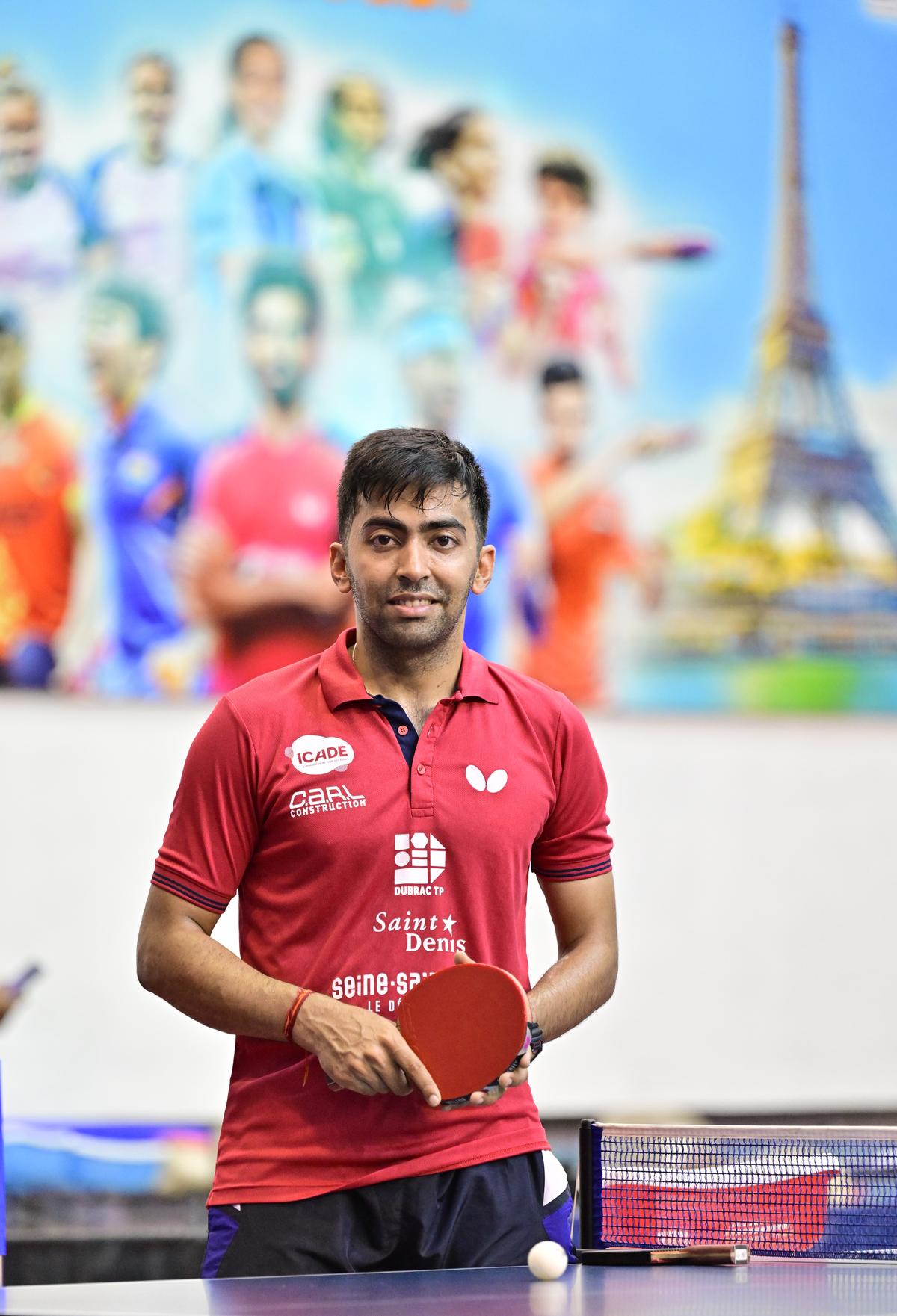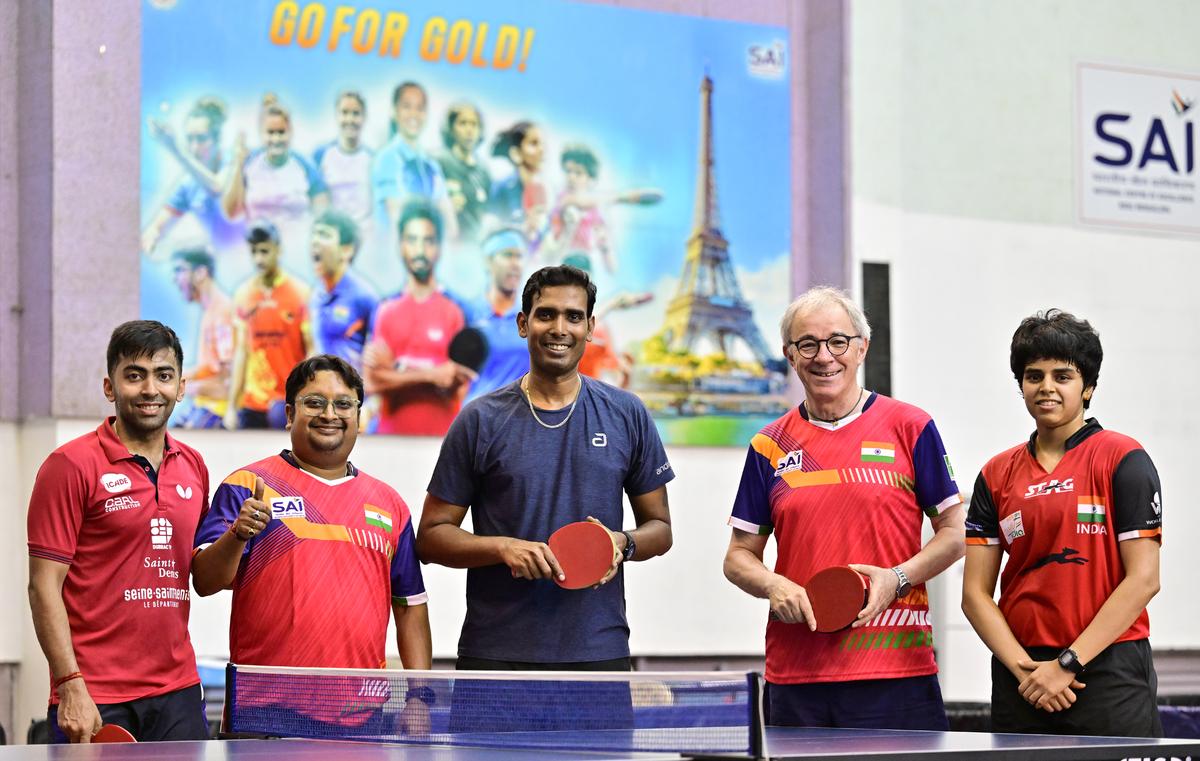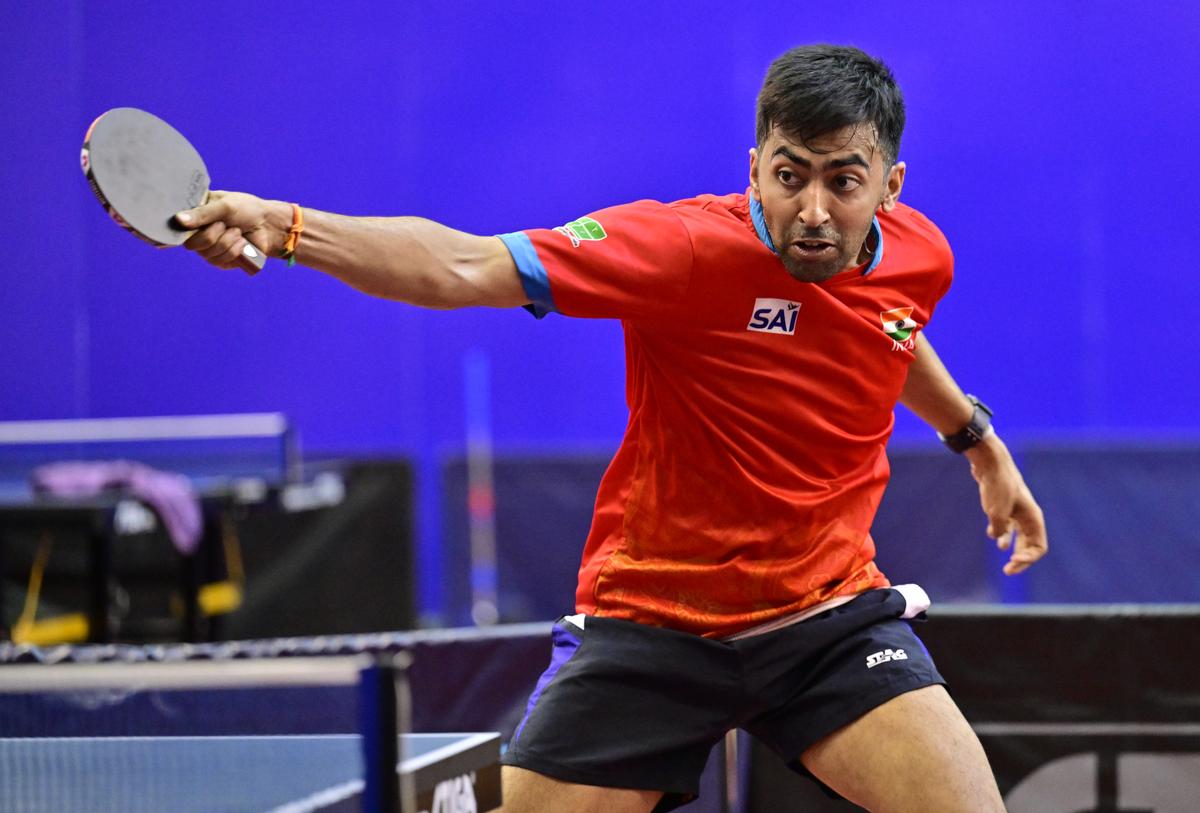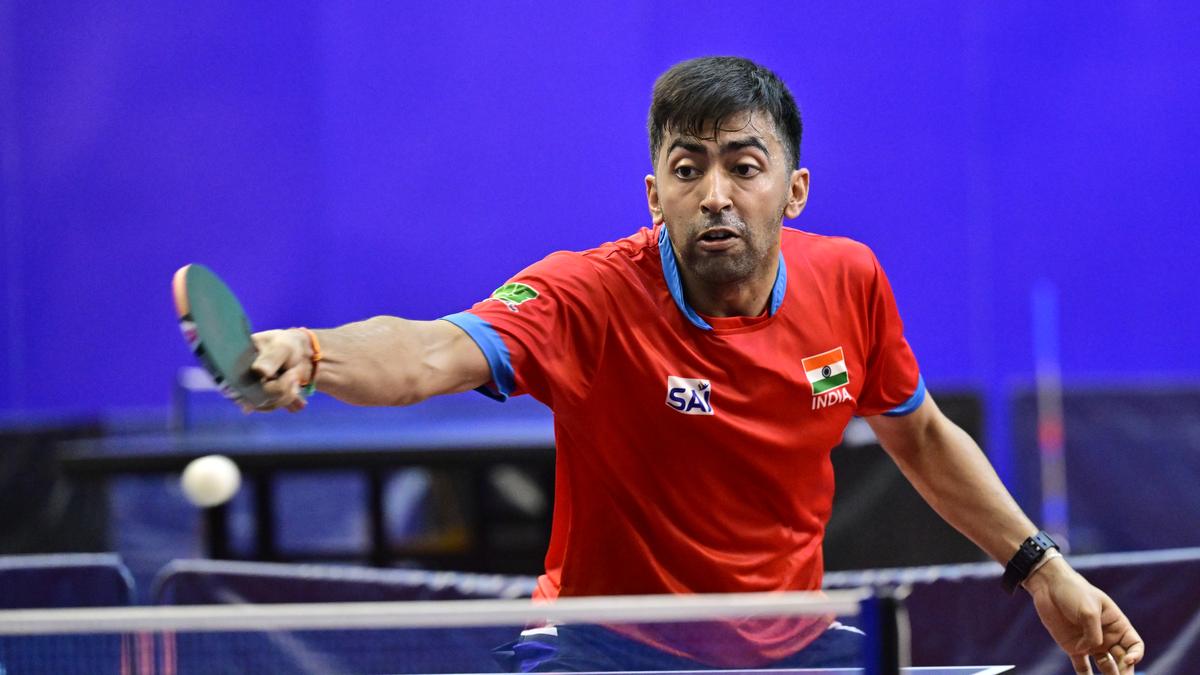Paris Olympics 2024: Harmeet Desai living his dream at the zenith of sport
Harmeet Desai is neither a party animal nor particularly inclined towards festivals or family functions. However, when the Indian table tennis contingent makes its debut at the Paris Olympics this month, it will be an occasion the 30-year-old from Surat will cherish. Not only will he fulfill his decade-old dream of becoming an Olympian, but he will also compete as one of the two men’s singles players, alongside veteran Sharath Kamal.
It has been a long wait, but it’s worth it. “It means a lot. It’s almost 24-25 years of hard work. I think it’s every sportsperson’s dream to represent their country in the Olympics. I am really excited and looking forward to playing my first Olympics,” Harmeet says in his trademark soft-spoken manner.
Listen to the full episode here
We are seated at the Sports Authority of India’s campus in Bengaluru, just hours before Harmeet experiences his final sunset in India before officially becoming an Olympian. After participating in three preparatory tournaments and undergoing personal training in Germany, he will join his teammates in Paris. This schedule means he won’t reunite with his family — parents Rajul and Archana, wife Krittwika, and elder brother Hraday — until August.
As he narrates his story, you can sense him reminiscing about his days as a five-and-a-half-year-old, hooked on three racquet sports — tennis, badminton, and table tennis. To play tennis, he had to venture out of his home in Surat. But for table tennis, he could play at home, thanks to his father Rajul, a university-level paddler, who had bought a table for home use.
Around four months after he was introduced to the game, Rajul realised that his son had ball sense — the innate quality required to be a paddler. He then asked Harmeet to choose one of the three racquet sports. “Standing on a tennis court, I told him I wanted to play table tennis. And ever since, my life has revolved around the game,” Harmeet says.
Once he got hooked, Harmeet’s life revolved around a 9’x5” table, and the Desai household revolved around his table tennis. Realising that Harmeet was meant to be an odd-one out in Surat — where kids typically aspired to join the renowned diamond hub or become stockbrokers — his parents adapted their professions to support him.
After winding up their stockbroking firm, Rajul devoted himself to Harmeet’s table tennis, while Archana, who was Harmeet’s first opponent at home, joined a school as a principal. Hraday, a fierce competitor on the table and still one of his tactical go-to persons, motivated him to dream bigger.
The family was keen on nurturing Harmeet’s passion for table tennis, which quickly developed into an obsession. But Surat, being a small town, lacked a sporting culture and the necessary expertise. As a result, Harmeet’s parents started inviting outstation coaches for sessions and sending him away on training stints since his early teen days.

Vital cog: He played an integral role in India winning a historic team bronze at the 2018 Asian Games and gold medals at the Commonwealth Games.
| Photo Credit:
K. Murali Kumar
Vital cog: He played an integral role in India winning a historic team bronze at the 2018 Asian Games and gold medals at the Commonwealth Games.
| Photo Credit:
K. Murali Kumar
Harmeet’s selection for and sustenance at the Petroleum Sports Promotion Board (PSPB) Academy in Ajmer for a year as an eight-year-old truly convinced his parents about his passion.
Since the early 1990s, the Academy has been the dream destination for aspiring paddlers in India, where Harmeet became the youngest ever to be selected. “I was just eight years old, and till date, nobody that young has enrolled in the Academy. I stayed there, and for my parents, it was a shock,” he recalls.
“When we went to Pune for the trials, they didn’t want to break my heart and thought such a young kid wouldn’t be selected anyway. But once I got selected, they were shocked. I wasn’t even thinking about staying away from my parents and family for a year. I stayed there for one year, went to a couple of national ranking tournaments, won a title in the under-10 category before coming back home due to homesickness. I was so young that I used to wet my bed at night.”
The one year at PSPB turned out to be a game-changer for Harmeet. Not only did it give him a taste of the outside world, but he also had to cope with being ragged by seniors. “They taught me swear words, and I had no clue they were swear words,” he says.
However, it was his wait for a phone call from home every evening — an STD call to the hostel — that eventually got to him. Having switched their careers and doing their best to fund his table tennis coaching, placing an STD call every day was not really affordable for the Desais. But they ensured that at least one of the extended family members called Harmeet to make him comfortable.
While the PSPB Academy has a reputation for making champions, it has also seen numerous cases of ruining promising careers. “There was a saying there that the one who leaves the Academy never becomes a player. I think it’s just me who came out of the Academy and made it into the senior team or played really well after that,” he says with a sense of pride.
“I wanted to prove to everyone that I could become good. After two or three years, I got another offer from the Academy, but I didn’t want to go.” By then, the household had established its own schedule. When he wasn’t training in Surat, Harmeet was travelling to various table tennis hubs in search of quality partners and training facilities. “I must have practised at every major training facility all over India,” he says. From Narkeldanga and Ultadanga in old Kolkata to the swanky gymkhana in Pune and clubs in Chennai, he would travel whenever he could.
While he trained somewhere or was taking exams in his hometown — “once the school failed me due to lack of attendance”— sometimes, Desai Sr. would travel alone to Senior National Championships, videotaping matches so that Harmeet could watch and improve his game. It was the pre- YouTube era, and such innovations helped Harmeet upgrade his skills. While he has worked with various coaches during his journey, he holds Swedish legend Peter Karlsson in high regard, ever since he travelled to his academy for the first time as a 16-year-old.
“Peter once told me in Sweden that table tennis is just 10-20 per cent of life. He said there are more important things like family or food. I didn’t understand what he meant at that time. For me, table tennis was life, and my life was always about table tennis. Whether I got more or less money didn’t matter. If the achievement was less or more, that didn’t affect me. It was always a constant.”

Focus on the basics: After cementing his place in India’s squad midway through the last decade, Harmeet started focusing on enhancing his skills.
| Photo Credit:
K. Murali Kumar
Focus on the basics: After cementing his place in India’s squad midway through the last decade, Harmeet started focusing on enhancing his skills.
| Photo Credit:
K. Murali Kumar
Since we are on a trip down memory lane, I ask him whether he recalls the first time he thought of becoming an Olympian. Pat comes the reply, “Soon after we won the World Junior Team Championship bronze.”
The trio of Harmeet, Soumyajit Ghosh — then the wonder boy of Indian table tennis — and G. Sathiyan had started idolising Sharath and aspiring to follow in his footsteps by then. While Ghosh had all but assured himself a ticket to London — the only Olympics Sharath failed to make the cut for since 2004 — Harmeet wasn’t thinking so big.
“I was young, but Ghoos (Ghosh’s nickname) was confident of qualifying for the Olympics. It took me some time to realise I could get there too, and around 2013, I really set my eyes on Olympic qualification. I had two near-misses for Rio and Tokyo, but that made me a better table tennis player,” he says.
After cementing his place in India’s squad midway through the last decade, Harmeet started focusing on enhancing his skills. He realised he needed to improve his short game, so he worked on his flicks during his training stints in Germany. This resulted in him playing an integral role in India’s historic team championship bronze at the 2018 Asian Games and gold medals at the Commonwealth Games.
Sharath admits that after failing to qualify as a team for Tokyo, Harmeet was very determined to help make it happen. Over the last three years, he emerged as India’s highest-ranked men’s singles paddler in the world, overtaking Sathiyan and Sharath for almost a year.
One cannot help but ask whether qualifying for the team event for the first time matters the most to him or if it’s his qualification as one of only two men’s singles entries from India.
“For me, the most important thing is representing the country at the Olympics, that too with Sharath bhaiya as India’s flag-bearer. Definitely, everybody has a personal preference, but for me, what matters the most is I will remember representing India in the Olympics.”
For every sports fanatic — let alone an athlete — the Olympics is associated with childhood memories. Harmeet is no exception. But his obsession with table tennis reflects in his early Olympic memories as well.

Harmeet’s year-long stint at PSPB as an eight-year-old convinced his parents about his passion.
| Photo Credit:
K. Murali Kumar
Harmeet’s year-long stint at PSPB as an eight-year-old convinced his parents about his passion.
| Photo Credit:
K. Murali Kumar
“It was 2000 when I saw Chetan Baboor’s picture in action. It was just a picture in a newspaper. Then in 2004, I followed Sharath Kamal. I don’t remember the result, but I think he played against a Spanish player,” he says.
“And then in 2008, I followed everything. I remember Abhinav Bindra winning the gold and Vijender Singh winning the (bronze) medal. From then on, I have been following everything.”
Everyone entering the Olympic village for the first time has a wishlist of things to do, both inside and outside the arena. Meeting idols, not necessarily from their own discipline, is often a main agenda. Ask Harmeet which athlete he is desperate to meet, and his eyes light up.
“Rafael Nadal,” he says. “It might be his last Olympics, so I would like to meet him. I’ve followed him since he won his first French Open title. I didn’t like Federer’s domination much at the time; I wanted someone to challenge him. My father liked Federer a lot, and when I saw Nadal, I liked his fighting spirit and never-give-up attitude. I have been following him a lot, so I’d like to meet him in Paris.”
It may be Nadal’s last Olympics, but Harmeet will definitely revel in his first. And if he can play a stellar role and help India make it a memorable team championship debut by advancing past the initial hurdle, he would all but ensure that Paris won’t be his only Olympic appearance.
Let the celebrations begin in July, also Harmeet’s birth month, and extend for months thereafter!



